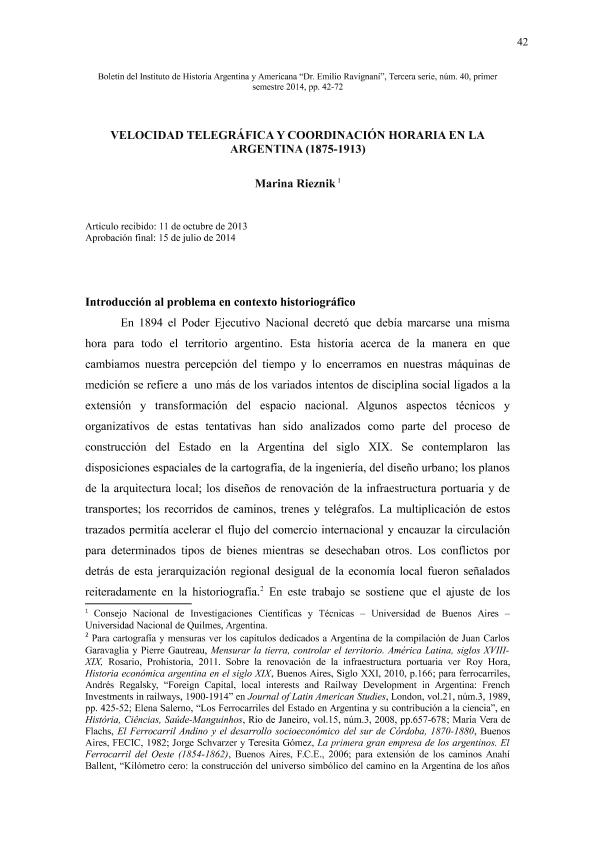Mostrar el registro sencillo del ítem
dc.contributor.author
Rieznik, Marina Andrea

dc.date.available
2018-02-05T21:26:25Z
dc.date.issued
2014-07
dc.identifier.citation
Rieznik, Marina Andrea; Velocidad telegráfica y coordinación horaria en la Argentina (1875-1913); Instituto de Historia Argentina y Americana Doctor Emilio Ravignani; Boletín del Instituto de Historia Argentina y Americana Dr. Emilio Ravignani; 40; 7-2014; 42-72
dc.identifier.issn
0524-9767
dc.identifier.uri
http://hdl.handle.net/11336/35703
dc.description.abstract
En 1894 el Poder Ejecutivo Nacional decretó que debía marcarse una misma hora para todo el territorio argentino. Cuando se decretaba esta unificación, los paladines de la disposición alegaban que se necesitaba cronometrar el territorio porque la sociedad debía organizarse en función de las velocidades de las nuevas tecnologías del telégrafo y del ferrocarril. Este artículo contrastará las dificultades materiales en la implementación de la telegrafía contra los discursos sobre el cambio brusco que supuestamente implicaba, poniendo en tela de juicio la urgencia en la coordinación horaria del territorio. Serán analizados informes del ejército sobre la telegrafía de guerra; artículos de una publicación aparecida desde 1912 llamada Revista Telegráfica; notas de la prensa diaria; debates parlamentarios y otras fuentes.
dc.description.abstract
In 1894, the Argentinean government issued a decree ordering to schedule a unified hour for the entire country. While this action was being put into effect, the supporters of the unification argued that to coordinate the time of the whole territory was needed to match social demands, and to organize the improvements brought on by some new technologies: telegraphs and railways. This article contrasts material difficulties found while implementing the telegraph, and the dominant speech, which praised the sudden changes that the telegraph supposedly implied by itself. It also put to question the urgency of time coordination for the whole country. In order to try it, we analyze reports from the army related to the use of the telegraph in war times; articles from a specialized publication, the Revista Telegráfica, which appeared in 1912; news articles; parliamentary debates, and several other sources.
dc.format
application/pdf
dc.language.iso
spa
dc.publisher
Instituto de Historia Argentina y Americana Doctor Emilio Ravignani
dc.rights
info:eu-repo/semantics/openAccess
dc.rights.uri
https://creativecommons.org/licenses/by-nc-sa/2.5/ar/
dc.subject
Estado
dc.subject
Territorio
dc.subject
Horario
dc.subject
Telégrafo
dc.subject
Ferrocarril
dc.subject.classification
Otras Ingeniería Mecánica

dc.subject.classification
Ingeniería Mecánica

dc.subject.classification
INGENIERÍAS Y TECNOLOGÍAS

dc.title
Velocidad telegráfica y coordinación horaria en la Argentina (1875-1913)
dc.type
info:eu-repo/semantics/article
dc.type
info:ar-repo/semantics/artículo
dc.type
info:eu-repo/semantics/publishedVersion
dc.date.updated
2018-02-05T20:16:04Z
dc.journal.number
40
dc.journal.pagination
42-72
dc.journal.pais
Argentina

dc.journal.ciudad
Buenos Aires
dc.description.fil
Fil: Rieznik, Marina Andrea. Consejo Nacional de Investigaciones Científicas y Técnicas. Universidad de Buenos Aires; Argentina
dc.journal.title
Boletín del Instituto de Historia Argentina y Americana Dr. Emilio Ravignani
dc.relation.alternativeid
info:eu-repo/semantics/altIdentifier/url/http://ref.scielo.org/y6y4tb
Archivos asociados
